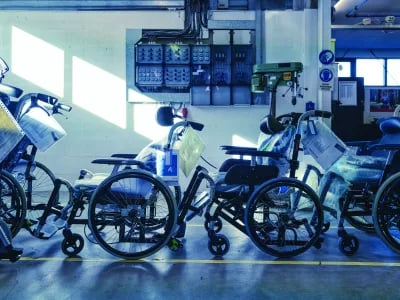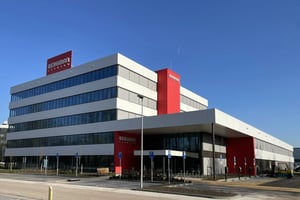Medux is the overarching name for a cluster of businesses that supply care and rehabilitation equipment and ancillary services to health insurers, local and national governments, healthcare institutions and healthcare professionals. Owing to its strong focus on quality, the Medux group has evolved into the absolute market leader in recent years. The downside to rapid growth: a structural shortage of qualified skilled technical workers. HR director Joyce Tieben and her team came up with a smart solution.
When Joyce Tieben started as HR director at Medux three years ago, she faced an urgent problem almost straightaway: more than two hundred job openings for qualified SVE (senior secondary vocational education) workshop and service technicians. ‘Our company had to go looking for people who were already scarce in the market. We also had to give these people additional training. On the other end, you also saw that the market, in turn, was tugging at our people. We weren’t making much progress. So I sat down with my team to try to find a more structural solution.’
There might have been a shortage of technicians — but there was no shortage of drivers who deliver and install healthcare equipment. Tieben: ‘These healthcare delivery drivers are generally quite dexterous, but, in most cases, hold a junior secondary vocational education diploma. We came up with the idea of training a few motivated healthcare delivery drivers internally each year to become technicians so that we could eliminate our shortages. However, there was one obstacle we needed to deal with: for a senior secondary vocational diploma, you have to work with a regional training centre, and they don’t offer a training programme for wheelchair service technicians.’
Bicycle technician
After consultation with the Tweewieler Academy (Innovam), we found out that the bicycle technician SVE programme could cover about 80% of the knowledge and skills required by Medux. ‘A bicycle and a wheelchair contain many of the same parts. The Tweewieler Academy works with ROC Midden Nederland. By letting our people attend the Tweewieler Academy one day per week for more than a year and a half, we were able to train our very own technicians’, says Tieben. ‘We supplemented this programme with a few modules that we developed in-house, and on-the-job training by workplace coaches from within our organisation.’
At the beginning of 2018, Medux started a pilot with fifteen healthcare delivery drivers from various regions of the country. Tieben did have to convince the involved managers beforehand. ‘What we were really saying, was: “Dear manager, may I please have the best, most motivated healthcare delivery driver from your team, and, by the way, you’ll have to miss them one day per week”’, she says laughing. ‘Also: when you send someone to a training programme, this person has to also spend a sufficient number of hours tinkering. That isn't possible if you're constantly deploying them as a healthcare delivery driver. In other words, this plan required some internal missionary work.’
Although the pilot did bring to light some teething problems — mainly in terms of communication and coaching — it did appear to be a great success. All fifteen former healthcare delivery drivers still work at Medux — and all fifteen in a different technical position. ‘A few became service technicians, a few became workshop technicians, and one employee even works as a rehabilitation technician’, says Tieben. ‘The latter is very much next level in the technical occupations, and rehabilitation technicians are incredibly scarce in the labour market. I am very proud that we now have these “homegrown” technicians on board.’
An asset in labour market communication
Meanwhile, the second group of healthcare delivery drivers have completed training, half of which have also graduated to a different position at Medux. According to Tieben, there appear to be more mutual benefits. ‘It’s relatively easier to find people for the position of healthcare delivery driver, and via this route, we can also potentially fill the hard-to-fill positions. But it’s also really nice for the people themselves who work their way up and get promoted: we notice that significantly fewer employees leave the company among this group that followed the training. This also gives us a trump card in labour market communications, because of course it’s quite attractive to start here as a healthcare delivery driver and then work your way up to a technical position’, explains Tieben.
When asked if anyone has dropped out of the programme yet, she says: ‘So far, not yet. At our locations, the managers generally know the employees rather well. In other words, when you ask them who has the ambition to work their way up, they nominate the right people for the programme. We also conduct a technical assessment beforehand. Everyone, except for two employees, passed the test.’ Last but not least, the programme is 100% inclusive, says Tieben. ‘We retrain men and women, from all regions and of all ages. Recently, a 60-year old employee asked if he was still eligible for this. I said: Of course. You still have seven years left to work, and in that time you can repair a whole lot of equipment.’
Read more: Duxxie: ease, transparency and efficiency













